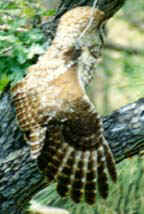
![]()
In general, the Quantile Functions (sometimes referred to as Inverse Density Functions or Percent Point Functions) return the Value X at which P(X) = [specified cumulative probability], given that particular distribution.
| Distributions | |||
| Beta | Chi Square | Logistic | Poisson |
| Binomial | Exponential | LogNormal | Student's T |
| Cauchy | F | Normal | Weibull |
![]()
- IDF_Beta: This
function takes the specified probability and returns the value X, such
that P(X) = P-value, given the Beta distribution with the two
specified Shape parameters. Because the formula for this function does
not exist in a closed form, it must be computed numerically. This
script arrives at the X-value through an iterative process, repeatedly
testing X-values with the CDF_Beta function until it arrives at P
value that is within 1x10-12 units from the specified
P-value (this usually takes between 30-60 iterations).
a) Parameters:
- P-value: Number (0 >= p >= 1)
- Shape1: Number > 0
- Shape2: Number > 0
b) Usages:
- From "Probability Distribution Calculator", select "Quantile (IDF)" and Beta distribution.
- (Avenue): theProb = av.Run("Jennessent.DistFunc”, {“IDF_Beta”, {P-value, Shape1, Shape2}})
- (Avenue): theProb = av.Run("Jennessent.TableDistFunc”, {“IDF_Beta”, {P-value, Shape1, Shape2}})
- (Avenue): theProb = av.Run("Jennessent.IDF_Beta",
{P-value, Shape1, Shape2})
| c) Function: | 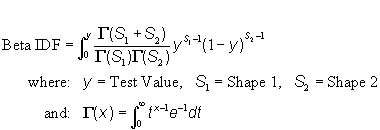 |
- IDF_Binomial:
This function takes the specified probability and returns the value X
such that the Probability of getting (X – 1) successes <= the Specified
Probability. This function takes an iterative approach to finding the
correct X value, repeatedly trying different values of X until it
reaches the correct one. This iterative process rarely takes more than
25 repetitions.
a) Parameters:
- P-value: Number (0 >= p >= 1)
- # Trials: Integer >= 2, # Successes
- Probability of Success: Number (0 >= p >= 1)
b) Usages:
- From "Probability Distribution Calculator", select "Quantile (IDF)" and Binomial distribution.
- (Avenue): theProb = av.Run("Jennessent.DistFunc”, {“IDF_Binomial”, {P-value, #Trials, Probability of Success}})
- (Avenue): theProb = av.Run("Jennessent.TableDistFunc”, {“IDF_Binomial”, {P-value, #Trials, Probability of Success}})
- (Avenue): theProb =
av.Run("Jennessent.IDF_Binomial", {P-value, #Trials, Probability of
Success})
| c) Function: |  |
a) Parameters:
- P-value: Number (0 >= p >= 1)
- Location: Number
- Scale: Number > 0
b) Usages:
- From "Probability Distribution Calculator", select "Quantile (IDF)" and Cauchy distribution.
- (Avenue): theProb = av.Run("Jennessent.DistFunc”, {“IDF_Cauchy”, {P-value, Location, Scale}})
- (Avenue): theProb = av.Run("Jennessent.TableDistFunc”, {“IDF_Cauchy”, {P-value, Location, Scale}})
- (Avenue): theProb = av.Run("Jennessent.IDF_Cauchy",
{P-value, Location, Scale})
| c) Function: |  |
a) Parameters:
- P-value: Number (0 >= p >= 1)
- Degrees of Freedom: Number > 0
b) Usages:
- From "Probability Distribution Calculator", select "Quantile (IDF)" and Chi Square distribution.
- (Avenue): theProb = av.Run("Jennessent.DistFunc”, {“IDF_ChiSquare”, {P-value, DF}})
- (Avenue): theProb = av.Run("Jennessent.TableDistFunc”, {“IDF_ChiSquare”, {P-value, DF}})
- (Avenue): theProb =
av.Run("Jennessent.IDF_ChiSquare", {P-value, DF})
| c) Function: | 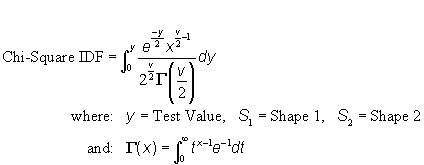 |
a) Parameters:
- P-value: Number (0 >= p >= 1)
- Mean: Number > 0
b) Usages:
- From "Probability Distribution Calculator", select "Quantile (IDF)" and Exponential distribution.
- (Avenue): theProb = av.Run("Jennessent.DistFunc”, {“IDF_Exp”, {P-value, Mean}})
- (Avenue): theProb = av.Run("Jennessent.TableDistFunc”, {“IDF_Exp”, {P-value, Mean}})
- (Avenue): theProb = av.Run("Jennessent.IDF_Exp",
{P-value, Mean})
| c) Function: |  |
a) Parameters:
- P-value: Number (0 >= p >= 1)
- 1st Degrees of Freedom: Number > 1
- 2nd Degrees of Freedom: Number > 1
b) Usages:
- From "Probability Distribution Calculator", select "Quantile (IDF)" and F distribution.
- (Avenue): theProb = av.Run("Jennessent.DistFunc”, {“IDF_F”, {P-value, DF1, DF2}})
- (Avenue): theProb = av.Run("Jennessent.TableDistFunc”, {“IDF_F”, {P-value, DF1, DF2}})
- (Avenue): theProb = av.Run("Jennessent.IDF_F",
{P-value, DF1, DF2})
| c) Function: | 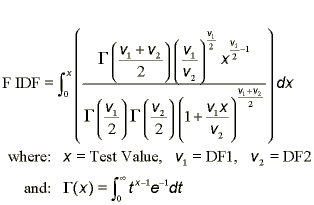 |
a) Parameters:
- P-value: Number (0 >= p >= 1)
- Mean: Number
- Scale: Number > 0
b) Usages:
- From "Probability Distribution Calculator", select "Quantile (IDF)" and Logistic distribution.
- (Avenue): theProb = av.Run("Jennessent.DistFunc”, {“IDF_Logistic”, {P-value, Mean, Scale}})
- (Avenue): theProb = av.Run("Jennessent.TableDistFunc”, {“IDF_Logistic”, {P-value, Mean, Scale}})
- (Avenue): theProb =
av.Run("Jennessent.IDF_Logistic", {P-value, Mean, Scale})
| c) Function: |  |
a) Parameters:
- P-value: Number (0 >= p >= 1)
- Mean: Number > 0
- Scale: Number > 0
b) Usages:
- From "Probability Distribution Calculator", select "Quantile (IDF)" and LogNormal distribution.
- (Avenue): theProb = av.Run("Jennessent.DistFunc”, {“IDF_LogNormal, {P-value, Mean, Scale}})
- (Avenue): theProb = av.Run("Jennessent.TableDistFunc”, {“IDF_LogNormal, {P-value, Mean, Scale}})
- (Avenue): theProb =
av.Run("Jennessent.IDF_LogNormal", {P-value, Mean, Scale})
| c) Function: |  |
a) Parameters:
- P-value: Number (0 >= p >= 1)
- Mean: Number
- Standard Deviation: Number > 0
b) Usages:
- From "Probability Distribution Calculator", select "Quantile (IDF)" and Normal distribution.
- (Avenue): theProb = av.Run("Jennessent.DistFunc”, {“IDF_Normal_Simpsons, {P-value, Mean, St. Dev.}})
- (Avenue): theProb = av.Run("Jennessent.TableDistFunc”, {“IDF_Normal_Simpsons, {P-value, Mean, St. Dev.}})
- (Avenue): theProb =
av.Run("Jennessent.IDF_Normal_Simpsons", {P-value, Mean, St. Dev.})
| c) Function: |  |
a) Parameters:
- P-value: Number (0 >= p >= 1)
- Mean: Number > 0
b) Usages:
- From "Probability Distribution Calculator", select "Quantile (IDF)" and Poisson distribution.
- (Avenue): theProb = av.Run("Jennessent.DistFunc”, {“IDF_Poisson, {#P-value, Mean}})
- (Avenue): theProb = av.Run("Jennessent.TableDistFunc”, {“IDF_Poisson, {P-value, Mean}})
- (Avenue): theProb =
av.Run("Jennessent.IDF_Poisson", {P-value, Mean})
| c) Function: | 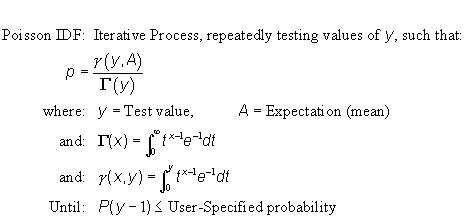 |
a) Parameters:
- P-value: Number (0 >= p >= 1)
- Degrees of Freedom: Number > 0
b) Usages:
- From "Probability Distribution Calculator", select "Quantile (IDF)" and Student’s T distribution.
- (Avenue): theProb = av.Run("Jennessent.DistFunc”, {“IDF_StudentsT, {P-value, DF}})
- (Avenue): theProb = av.Run("Jennessent.TableDistFunc”, {“IDF_StudentsT, {P-value, DF}})
- (Avenue): theProb = av.Run("Jennessent.IDF_StudentsT", {P-value, DF})
c) Function: The IDF_StudentsT T Function is dependent on whether the test value is positive or negative:
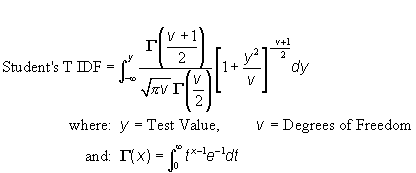 |
a) Parameters:
- P-value: Number (0 >= p >= 1)
- Location: Number
- Scale: Number > 0
- Shape: Number > 0
b) Usages:
- From "Probability Distribution Calculator", select "Quantile (IDF)" and Weibull distribution.
- (Avenue): theProb = av.Run("Jennessent.DistFunc”, {“IDF_Weibull, {P-value, Location, Scale, Number}})
- (Avenue): theProb = av.Run("Jennessent.TableDistFunc”, {“IDF_Weibull, {P-value, Location, Scale, Number}})
- (Avenue): theProb =
av.Run("Jennessent.IDF_Weibull", {P-value, Location, Scale, Number})
| c) Function: |  |
![]()
Back to Statistics/Distributions | Summary Statistics | Probability Calculators | References
Calculating Summary Statistics with Avenue
Discussion of Distribution Functions:
Probability Density Functions | Cumulative Distribution Functions |
Quantile Functions
Download Statistics Extension Manual (Adobe PDF, version 5)
![]()
Please visit Jenness Enterprises ArcView Extensions site for more ArcView Extensions and other software by the author. We also offer customized ArcView-based GIS consultation services to help you meet your specific data analysis and application development needs.
